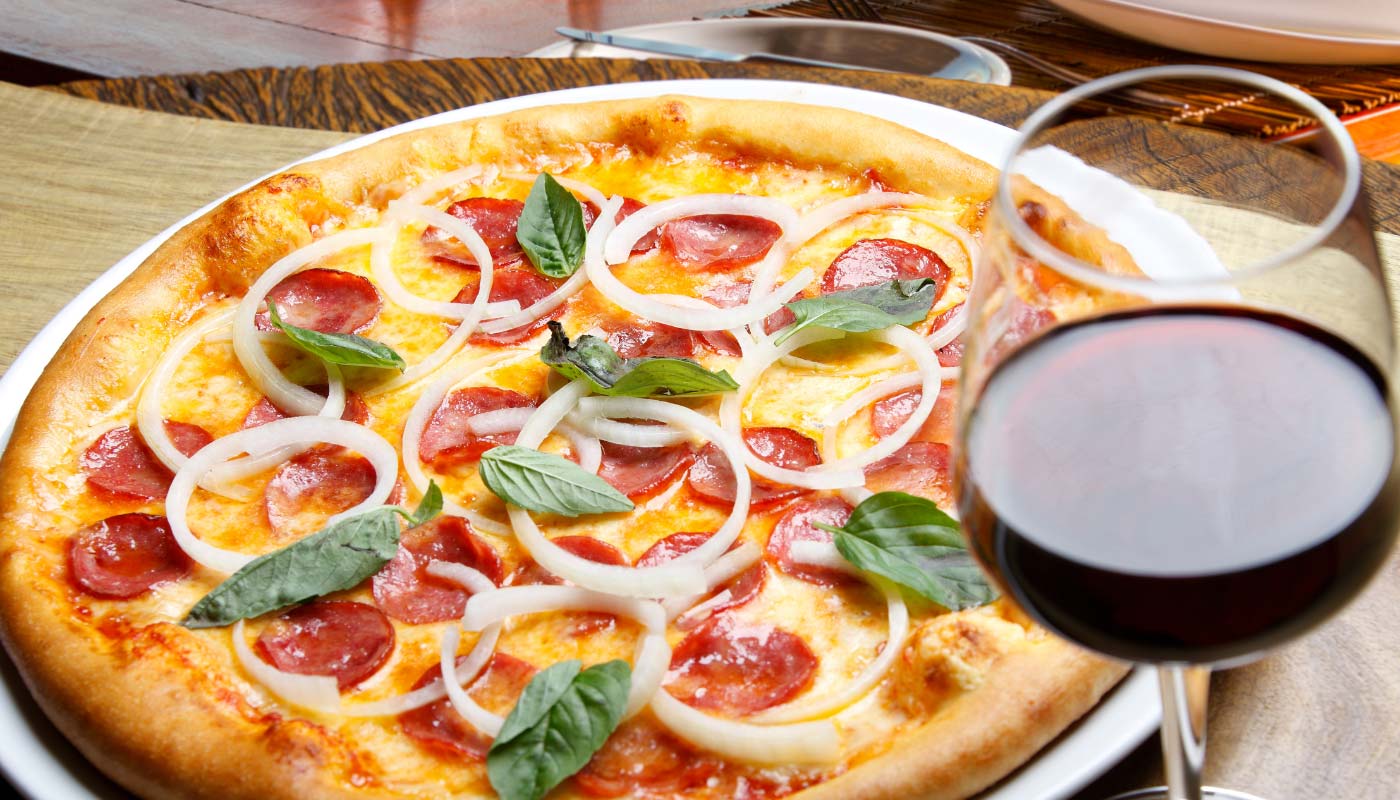Hello and welcome to Friday. You’ve reached the finish line of a long week, the promise of a glorious week-end looms and there are things you DO and DO NOT want to do.
You DO NOT want to go to the grocery store. You DO NOT want to look up a recipe online and scroll through the author’s life story before getting to the actual recipe. You DO NOT want to cook.
You DO want to stuff your face with crusty, cheesy gooey deliciousness. You DO want to wash that down with wine. Surrendering to this animal instinct does not mean you have to abandon your sharply honed wine sensibilities and grab a jug of plonk by the neck. Yes, you can geek out on pairing wine and pizza and that’s what we’re about to do.
There exists an almost infinite variety of pizza. Sauce: red, white, only EVO, perhaps pesto? Toppings: Meaty or Veggie? Margherita, Clams, BBQ?!!! Crust: thick, thin, cracker, stuffed? Style: Grandma, Chicago, New York, Sicilian, Detroit, Naples, New Haven? The mind boggles and the mouth waters. None of it is wrong and all of it is good. This should be starting to remind you of something. Declaring one superior to another is a sure-fire way to start an argument. Also sound familiar? Yes, the answer is WINE. Equally endlessly engaging, deeply satisfying to both the intellect and senses. This is why you love them both and they love each other. Of course, like all of your friends, some get along better than others. Successful match-making considers a few basic personality traits and the fundamental rules of engagement. Presented here are strategies simple enough to be compatible with Friday Brain:
The Basics
There are several elemental components of wine and the key to a killer pairing is understanding how each interacts with their counterparts in pizza.
By and large the flavors and aromas of wine are described in terms of fruit and flowers. With a few new-fangled exceptions, pizzas are not topped with fruit or flowers, so there’s very little in common here. Somewhat less frequently, vegetal and earthy descriptors are used for wine and here we find some crossover. Mushroom, for example, often attributed to Pinot Noir and possibly the most popular vegetable on pizza. Bell pepper enjoys a strong, if marginal, fan base in the pizza world while its taste and smell are a distinct marker for some wines made from Cabernet Sauvignon. Beyond those examples, the overlap lessens. An argument can be made for Sauvignon Blanc and asparagus but if you’re putting asparagus on pizza you’re probably doing it wrong.
Acid is one of wine’s primary structural characteristics and plays two roles in a pairing with pizza: Primarily it balances the richer, heavier elements like cheese, white sauce, oil, and fatty meats by cleansing and refreshing the palate. It also provides harmony by matching the high acidity of sauce ingredients and toppings like tomatoes, olives, onions, and anything pickled. Wines particularly strong in doing this double duty are Chianti, Valpolicella and Barbera from Italy, Portuguese red blends, and Sauvignon Blanc and Pinot Grigio from almost everywhere.
Tannin is another important structural component in wine, most recognized by the grippy, tacky feeling it leaves in your mouth. Spicy foods tend to exaggerate that sensation which takes high-tannin wines like Cabernet Sauvignon, Syrah, Nebbiolo and Petit Sirah off the pairing menu for most pizza. On the other hand, if you can lay off the shaker of red pepper flakes, pizza’s high dairy and fat content ingredients are a plus. They “soften” the impact of tannins on your palate to reveal other flavors. In this case, the pairing is a bit one-sided in that the pizza is clocking in to increase your enjoyment of the wine. Pizza is cool with that, though. It is nothing if not unselfish.
Lastly, we consider sweetness – defined as the presence of sugar in the wine. When confronted with anything spicy, a sweet wine, or rather the sugar in it, puts that fire right out. This is especially comforting with the modern advent of thai and bbq flavors on pizza in addition to the traditional sources (see: chili flakes, above). Sweet wine choices, mainly Riesling but also Gewurztraminer, Moscato and (sometimes) Pinot Gris can also be employed to match sweet flavors on pizza, of which there is really only one: PINEAPPLE! And there it is… the football shaped elephant in the room. In the interest of journalistic integrity, this article will reserve judgment on the heathens who deface the World’s Most Perfect Food in such a way. Your divisive preference will be indulged.
This review of the fundamental pizza-wine interactions may be all you need to embark on your pairing adventure. Should you desire more specific guidance coupled with a more holistic approach, sort of whole pie vs slice, read on!
Next Level:
In terms of flavor, aroma and texture, wine and pizza can each be extremely complex. Think Barrel Aged California Red Blend and Meat Lovers Supreme Deluxe. Introducing two complex pizza and wine friends can present a challenge to your palate. Imagine having two speakers on opposite sides of a room, each playing different pieces of classical music. You’re standing in the middle with zero chance of appreciating the nuances of either. You likely can’t even tell them apart. The multiple layers of sound overlap and clash, the very definition of static. Same with pizza and wine, a barrage of disparate flavors from each will overwhelm your taste buds resulting in an indistinct muddle. The solution, the path to a good match, is pairing complex with simple, resulting in a harmony of flavors. It doesn’t matter which is which. There are desirable pizza and wine options of both types. For the sake of the following examples, however, pizza is going to lead the dance. This is likely how your Friday will actually go: order the pizza, pick the wine.
Simple Pizza / Complex Wine
Important to note that “simple” does not mean “boring”. In the context of pizza, “simple” is 1-2 toppings. These are the classics: Pepperoni & Mushroom, Sausage & Onion, Margherita. In this pairing scenario the pizza is a firm but mostly blank background on which the flavors of the wine are projected.
Chianti, an Italian wine based on the Sangiovese grape, is a great choice here. It leads with red fruit and herbal flavors backed by firm tannins and paced by bracing acidity. All the feels, amplified by the simple savory notes of the pie.
Rosso de Montalcino and Carmignano, neighbors to Chianti also made from Sangiovese, deliver similar thrills.
Complex Pizza / Simple Wine
Under the heading of “Complex” falls whatever is not “Simple”: multiple meats, various veggies, a collection of cheeses, serious sauces. The goal here is for the multitude of flavors of the pizza to frolic upon the supportive, but relatively neutral, foundation of the wine. As with pizza, a “simple” wine is not one lacking in character or depth or quality. It’s a wine defined by one or two primary flavors. When those flavors are bold and consistent, they make an excellent partner to food.
Spanish wines made from the Grenache grape are a perfect example. Juicy fruit from beginning to end, thirst-quenching and moreish. Happy to have been invited to the party and willing to cede the spotlight to whatever’s on your pizza.
Look for the regions of Campo de Borja and Cariñena or mix it up with a Rose from Navarra.
Hawaiian Pizza / ?? Wine
First choice for pairing is, of course, Pineapple wine. This is a real thing and they deserve each other.
In all seriousness, the combination of salty, acidic, and sweet demands a substantial and fearless wine partner. Riesling is the only way to go. Naturally high in acid, it syncs with the sauce and plays nice with the pineapple. Residual grape sugars work the other way, matching sweetness and taming spice. Finally, high-quality, high-toned examples can be said to express “salinity”, enhanced by the ham.
Off-dry to medium-sweet bottlings from the German region of Pfalz should be your first choice but wines from New York State and Washington will do nicely as well.
If this all strikes you as a little too much work for a Friday night, let us not forget that the whole point is to have fun. Luckily, the most fun wine of all is also a multi-talented Pairing Ninja. Of course we’re referring to Bubbles.
Sparkling wines typically have all the components thus far established as necessary for a good pizza pairing: high acid, refined fruit flavors and sometimes a bit of sweetness. They also have a secret weapon that truly elevates their matching prowess. Sparklers made via the “traditional method” have distinct flavors and aromas of yeast, i.e. bread, i.e. PIZZA CRUST!!!! Unlock this third dimension of pairing with wines from Champagne or Cava. Prosecco and others lack that yeasty quality but deliver more fruitiness. Try them both, remember the goal is maximum fun.
As it is for this entire exercise. An old adage about pizza claims that “even when it’s bad it’s good.” The same goes for pairing pizza with wine. It is nearly impossible to screw up. If you like the pizza and you like the wine, who cares what the acids and tannins are doing with each other? Use the information provided here to guide your adventure but don’t be afraid to experiment. The recommendations are intended as jumping off points not doctrine. Wine is a deep and wide pool into which you can wade, swim or dive. It’s up to you but be sure to get out when it stops being fun.





